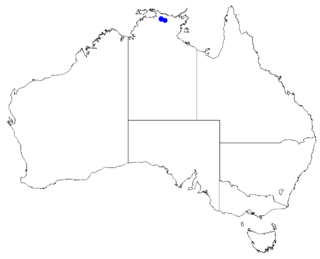
Boronia algida, commonly known as alpine boronia, is a flowering plant in the citrus family, Rutaceae and is endemic to south-eastern Australia. It is an erect shrub with many branches, pinnate leaves and white to bright pink, four-petalled flowers usually borne singly on the ends of branches.

Boronia safrolifera, commonly known as safrole boronia, is a species of flowering plant that is endemic to eastern Australia. It is an erect, woody shrub with pinnate leaves that have up to nineteen leaflets, and white to pink, four-petalled flowers.

Boronia forsteri is a plant in the citrus family Rutaceae and is endemic to mountain ranges in central Queensland, Australia. It is an erect shrub with many branches, simple leaves with a densely hairy, pale underside, and pink, four-petalled flowers.

Boronia granitica, commonly known as granite boronia, is a plant in the citrus family, Rutaceae and is endemic to a small area of eastern Australia. It is an erect shrub with many branches, compound leaves and pink, four-petalled flowers.

Boronia filicifolia is a plant in the citrus family, Rutaceae and is endemic to the far north-west of Australia. It is an erect or sprawling shrub with many branches, pinnate leaves with up to 55 leaflets and white to pink flowers with the sepals a similar length to the petals.

Cyanothamnus inflexus is a plant in the citrus family Rutaceae and is endemic to tablelands near the New South Wales - Queensland border in Australia. It is an erect, woody shrub with pinnate leaves and up to seven white to pink four-petalled flowers in the leaf axils. Boronia bipinnata is similar but has larger, bipinnate or tripinnate leaves and smaller sepals and petals.
Boronia minutipinna is a plant in the citrus family Rutaceae and is endemic to a small area in the Kimberley region of Western Australia. It is an erect shrub with many branches, hairy stems and leaves, pinnate leaves and white to pink, four-petalled flowers with the sepals longer and wider than the petals.
Boronia quadrilata is a species of plant in the citrus family Rutaceae and is endemic to a small area in the Northern Territory, Australia. It is an erect, glabrous shrub with simple, sessile, wedge-shaped leaves, pale yellow petals and green sepals that are longer and wider than the petals. It is only known from a population of about fifteen plants.

Boronia revoluta, commonly known as Ironcap boronia, is a plant in the citrus family, Rutaceae and is endemic to the south-west of Western Australia. It is an erect shrub with three-part leaves and pink or white, four-petalled flowers.

Boronia rupicola is a species of plant in the citrus family Rutaceae and is endemic to a small area in the Northern Territory, Australia. It is a small shrub with weeping branches, simple or pinnate leaves and small, green, inconspicuous flowers.

Boronia splendida is a species of plant in the citrus family, Rutaceae, and is endemic to Queensland, Australia. It is an erect shrub with most parts covered with star-like hairs and has simple, linear to narrow elliptic leaves, and pink to white, four-petalled flowers.

Boronia squamipetala is a species of plant in the citrus family, Rutaceae, and is endemic to Queensland, Australia. It is an erect shrub with pinnate leaves with between five and thirteen elliptic leaflets, and green to white, four-petalled flowers with hairy backs.

Boronia suberosa is a species of plant in the citrus family Rutaceae and is endemic to a small area in the Northern Territory, Australia. It is a shrub with weeping branches, simple leaves, and flowers with four small, white petals.

Boronia tolerans is a plant in the citrus family, Rutaceae and is endemic to a small area in the Northern Territory in Australia. It is an erect shrub with many branches, pinnate leaves and white, four-petalled flowers. It is only known from Nitmiluk National Park.

Boronia wilsonii is an erect shrub that is endemic to northern Australia. Its branches, leaves and backs of the flowers are densely covered with woolly hairs. The petals are white to pink or burgundy-coloured.

Boronia verecunda is a species of small, erect shrub that is endemic to a small area in the Northern Territory. The flowers are borne singly in leaf axils and are white or pink but turn green as the fruit matures. It is similar to B. xanthastrum.

Boronia viridiflora is a species of shrub that is endemic to a small area in the Northern Territory and grows horizontally from vertical rock faces. The flowers are borne singly or in groups of up to three in leaf axils and are green with a burgundy tinge.

Cyanothamnus warangensis is a species of erect, woody shrub that is endemic to Queensland. It has bipinnate leaves and groups of between five and twenty-five or more white flowers in leaf axils.
Cyanothamnus yarrowmerensis is a species of erect, woody shrub that is endemic to Queensland. It has pinnate or bipinnate leaves and groups of up to seven flowers with white petals in leaf axils.
Boronia zeteticorum is a species of small, semi-prostrate shrub that is endemic to a restricted part of the Northern Territory. It has hairy branches, leaves and flower parts, simple leaves and white flowers with the sepals longer and wider than the petals.

















